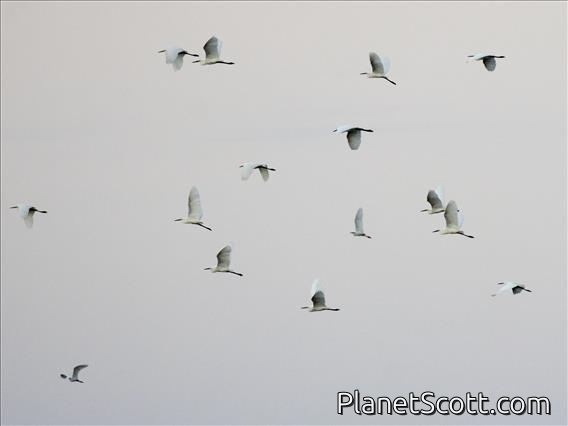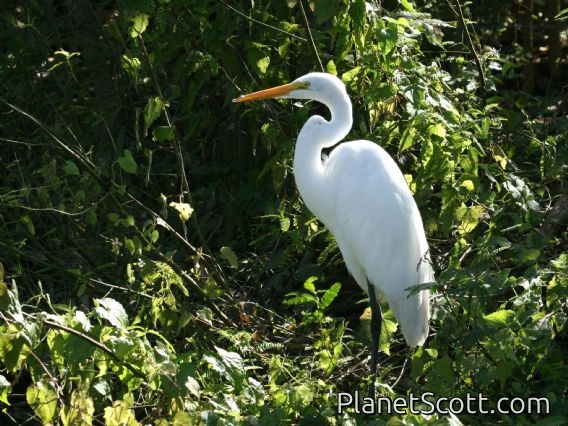Great Egret (Ardea alba)

Great Egret (Ardea alba)

Great Egrets (Ardea alba) - And One Little Egret

Great Egret (Casmerodius albus)



×




Great Egret (Ardea alba)

Great Egrets (Ardea alba) - And One Little Egret

Great Egret (Casmerodius albus)
About Great Egret (Ardea alba)
- Kingdom: Animals
- Phylum: Chordates
- Class: Birds
- Order: Pelicans
- Family: Herons
The great egret, also known as the common egret, large egret, great white egret, or great white heron, is a large, widely distributed egret. The four subspecies are found in Asia, Africa, the Americas, and southern Europe. Recently, it has also been spreading to more northern areas of Europe. Distributed across most of the tropical and warmer temperate regions of the world, it builds tree nests in colonies close to water.
Source: Wikipedia
Lifelists
Trips
- Africa: Egypt and Ethiopia
- Antarctica and Argentina
- Argentina
- Around The World in 66 Days
- Australia - Tasmania and Victoria
- Brazil
- Chicago
- Chile
- Chile 2020
- China Solar Eclipse
- Colombia - Santa Marta
- Costa Rica
- Cuba
- Dominican Republic
- Eastern Australia
- Ecuador
- Galapagos Islands
- India
- Indonesia
- Indonesia
- Japan
- Kenya Solar Eclipse
- Lesser Antilles
- Madagascar
- Malaysia
- Malaysia and Sumatra
- Mexico
- Mexico, Baja California Sur
- Mexico to Panama
- Mexico, Veracruz
- Morocco
- Moving the Car
- New Zealand
- Panama
- Peru
- Puerto Rico
- San Francisco 2007
- Southern Ecuador
- Tanzania
- Texas
- Turkey
- Uganda and stops between
- Western Australia
Visits
-
2001-05-01
Bair Island, United States of America -
2001-06-21
-
2001-12-28
Puerto Vallarta, Mexico -
2002-06-06
Bolinas Marsh, United States of America -
2005-02-18
Buenos Aires Reserva Costeneras, Argentina -
2006-01-09
Kheoladeo National Park, India -
2006-01-20
-
2006-03-23
Sultan's Marsh Bird Paradise, Turkey -
2006-11-11
Sani Lodge, Ecuador -
2006-12-05
Isla Santa Cruz - Turtle Bay, Ecuador -
2007-01-01
Candlestick Park, United States of America -
2007-04-07
Torrey Pines State Reserve, United States of America -
2007-06-14
Cape May Point State Park, United States of America -
2007-10-10
La Mancha, Mexico -
2007-12-15
Golden Gate Park - Lloyd Lake, United States of America -
2008-02-17
San Jose del Cabo - Estuary, Mexico -
2008-07-13
Jamaica Bay National Wildlife Refuge, United States of America -
2009-01-14
Cozumel, Mexico -
2009-01-18
Lamanai Ruins River Trip, Belize -
2009-01-23
Half Moon Caye, Belize -
-
2009-02-18
Parque National Palo Verde, Costa Rica -
2009-03-15
Boca de Cupe, Panama -
2009-05-08
Burnidge Forest Preserve, United States of America -
2009-07-14
Sai Kung Peninsula, Hong Kong -
2009-07-15
Hong Kong Wetland Park, Hong Kong -
2009-11-22
Palo Alto Baylands, United States of America -
2009-11-29
Heron's Head Park, United States of America -
2009-12-31
Palo Alto Baylands, United States of America -
2010-01-03
Sacramento National Wildlife Refuge, United States of America -
2010-02-18
Patzcuaro, Mexico -
2010-06-21
Cape May Point State Park, United States of America -
2010-10-30
Miller Meadow Forest Preserve, United States of America -
2011-01-04
Lake Langano - Bishangari Forest, Ethiopia -
2011-01-11
Hawassa Bridge, Ethiopia -
2011-07-10
Santa Fe River, United States of America -
2011-07-15
Pantanal, Brazil -
-
2012-07-10
Chase Lake NWR, United States of America -
2012-07-11
McKenzie Slough, United States of America -
2012-08-12
Redwood Shores - Radio Road, United States of America -
2012-09-07
Heron's Head Park, United States of America -
2012-09-23
Heron's Head Park, United States of America -
2012-11-06
Cairns Esplanade, Australia -
2012-11-11
Lakefield National Park, Australia -
2012-11-13
Keatings Lagoon Conservation Park, Australia -
2012-12-13
Heron's Head Park, United States of America -
2013-01-08
-
2013-01-18
Hoi An, Vietnam -
2013-01-24
Nam Cat Tien National Park, Vietnam -
2013-02-01
Ang Trapeang Thmor, Cambodia -
2013-02-02
Pak Thale, Thailand -
-
2013-02-14
Kaziranga NP, India -
2013-03-04
John Heinz NWR at Tinicum (IBA), United States of America -
2013-04-15
Balcones Canyonlands NWR--Refuge HQ (Travis Co.), United States of America -
2013-04-16
Aransas NWR (CTC 037) (Aransas Co.), United States of America -
2013-04-17
Brazoria NWR (UTC 108), United States of America -
2013-04-18
Galveston Island, United States of America -
2013-04-19
Bolivar Peninsula, United States of America -
2013-04-19
Anahuac NWR (UTC 049), United States of America -
2013-04-20
Attwater Prairie Chicken National Wildlife Refuge, United States of America -
2013-10-25
Lake Nakuru National Park, Kenya -
2013-11-01
Kalokol, Kenya -
2014-01-01
Heron's Head Park, United States of America -
2014-01-11
Heron's Head Park, United States of America -
2014-01-21
Jimani, Dominican Republic -
2014-01-22
Laguna de Oviedo, Dominican Republic -
2014-01-22
Cabo Rojo - Pedernales, Dominican Republic -
2014-01-26
Los Haitises National Park, Dominican Republic -
2014-02-22
Santa Fe Grade, United States of America -
2014-03-11
Elkhorn Slough, United States of America -
2014-04-06
Delta Meadows State Park, United States of America -
2014-06-14
Peaarson-Arastradero Preserve, United States of America -
2014-09-23
Redwood Valley, United States of America -
2014-10-08
Golden Gate Park - South Lake, United States of America -
2014-12-07
Sutro Heights--Baths / Land's End, United States of America -
2014-12-21
Arrowhead Marsh, United States of America -
2014-12-27
Heron's Head Park, United States of America -
2015-01-02
Pixley NWR, United States of America -
2015-01-03
Woodward Park, United States of America -
2015-01-10
Half Moon Bay - Pillar Point, United States of America -
-
-
-
-
-
-
-
-
-
2016-01-04
Reserva Natural Laguna Cartagena, United States of America -
-
-
-
-
2016-09-07
Urubamba, Peru -
-
-
-
2017-01-01
Mabamba Swamp, Uganda -
-
2017-01-09
Queen Elizabeth II National Park, Uganda -
2017-01-15
Umm Al Quwain, United Arab Emirates -
-
-
-
-
-
-
-
-
-
-
-
-
-
-
-
-
-
-
-
-
-
-
-
-
-
-
-
-
-
-
-
-
-
-
-
-
-
-
-
-
-
-
-
-
-
-
-
-
-
-
2023-01-03
Golden Gate Park - San Francisco Botanical Garden, United States of America -
-
-
-
-
-
-
-
-
-
-
-
-
-
-
-
-
-
-
-
-
-
-
-
-
-
-
-
-
-
-
2024-02-29
Kyoto - Botanical Gardens, Japan -
-
-
-
-
-
-
-
2024-08-12
Bali Barat National Park, Indonesia -
-
-
-
-
-
-
-
-
-
-
-
-
-
-
-
-
-
-
-
-
-
-
-
-
-
-
2025-11-17
Western Treatment Plant, Australia -
2025-12-05
Milawa, Australia






